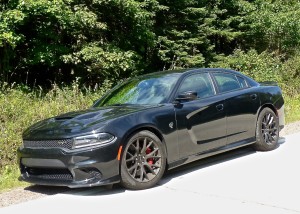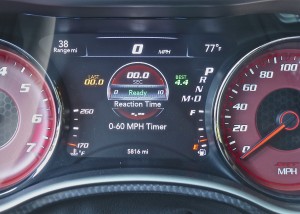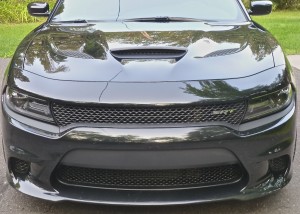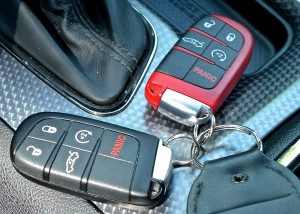Charger Hellcat Offers 707-HP Family Sedan
By John Gilbert
Maybe you’ve heard about the techniques of professional drag-racing, where drivers line up at the amber starting lights, then time it as perfectly as they can to launch without “red-lighting” an instant before the green light shows.
If you can find a place to try that in the ol’ family truckster, it’s fun. And if you happen to be driving a 2015 Dodge Charger SRT Hellcat, it’s more than just fun. Sure, it costs a little more than the garden variety Charger — close to $65,000 — but it comes fitted with a 707-horsepower supercharged 6.2-liter Hemi, and various accompanying toys.
One of them is that on the instrument panel, along with showing you your speed and RPMs and fuel gauge, you can switch to several screens. One of them, under “performance,” gives you a cluster of numbers between the speedometer and tach. Set it for 0-60, or 0-100, or a quarter-mile, and then hit the button when you’re ready to go. It counts down, and when it gets to your starting time, you accelerate as hard as you dare. The readout not only gives you a timed clocking of how you did, but it also shows your starting-line reaction time, for how close you cut the launch to the quickest possible time.
I found a deserted stretch of rural highway, and set the device for 0-60. Then I hammered it. After a couple runs, I showed a best time of 4.4 seconds. Dodge says the car will do the quarter mile in less than 14 seconds, and I have no reason to question that. If you know of a deserted stretch of rural highway, you realize immediately that you could spend a few bucks refueling before you get over the adrenaline kick of spending an afternoon playing with that Charger Hellcat.
The best thing about it, along with the looks and the amazing performance, is that when you simply start the engine and crack the throttle, people stop and stare, while you’re just happy your windows didn’t shatter.
The Dodge Charger had become something of a throwback, a large sedan with sporty overtones, which in a world of sleek and high-tech competitors seemed to have a questionable future. But as things have evolved, the Charger has matured into a a grown-up sedan for all seasons, starting with a potent 3.6-liter Pentastar V6, with 292 horsepower and available all-wheel drive. Move up to the legendary Hemi V8, and you can choose the 5.7-liter version with 370 horses and 395 foot-pounds of torque, or the Scat Pack with a 6.4-liter V8, 485 horses and 475 foot-pounds of torque. More than enough power…if there was such a thing. Of course, there isn’t.
Dodge decided that if it was going to compete with similarly retro ponycars like the Ford Mustang and Chevrolet Camaro, it would bring back the Challenger, which really was a Charger fitted with a coupe body. Heavy, yes, but with the Hemi engine, it has been a successful muscle car.
Dodge SRT engineers weren’t done, and they created the mind-blowing supercharged Hellcat version of the 6.2-liter Hemi, which develops 707 horsepower and 650 foot-pounds of torque, efficiently working to hurl the Challenger or the Charger Hellcat to a measured top speed of 204 miles per hour.
That made the Challenger one of the fastest cars on the planet, and with the same powertrain, the Charger becomes the fastest and most powerful full-size sedan ever built, and in my opinion, simply feels more balanced with all that power.
In the process, Dodge also redesigned the Charger for 2015, with some neat contours in the sides of its sleek body, and a meaningful hood scoop back there behind a new macho-looking grille. I still like the looks of the Challenger, but if you’re like I am, the Charger is the first 4-door sedan you might prefer to its 2-door coupe sibling.
For sheer sporty driving, a Chevy fan isn’t about to choose an Impala or Malibu over a Camaro, and Ford buyers aren’t looking at a Taurus or Fusion above the Mustang. But the Charger is properly nasty looking, and I prefer it as a balanced and enormously powerful sports sedan that you can enjoy even while you take your neighbors out for a ride in the back seat.
Mark Troestle, Dodge’s manager of the SRT performance arm, said the Charger redesign came from the simple objective of: “Making the front end as outrageous as 707 horsepower is. We have a different grille with a more prominent chin.
“We wanted to build the quickest, fastest and most powerful full-size sedan in the world. It’s tighter, leaner, like it’s shrink-wrapped. It’s both rational and emotional. And when you park it and walk away from it in a parking lot, you’ll look back just to see how cool it is.”
The roof and rear doors are the only panels remaining from the previous Charger. It’s a bit lower, and wider, and the LED foglights underline the attention to detail of the front, while pulling the C pillar rearward, practically onto the decklid, stresses the length and wraps into the rear corners, where the signature Dodge taillights show the flow of LEDs that encircle the whole rear panel.
The interior has an 8.4-inch touchscreen, and new seat design provides improved support. The steering wheel is sports-minded too, with a flat bottom and comfortable grip areas. There are paddles on either side of the steering wheel for shifting the 8-speed automatic manually.
You also get two key fobs with the car, one red and the other black. When you’re going somewhere, you use the red one, and enjoy all that power and fabulous sound. If you have another family member taking the Charger SRT Hellcat for the evening, you can give them the black key fob. They might not even realize that with the black key, the engine is limited to 500 horsepower, rather than the full 707.
As if nobody could get in over their heads with 500 horsepower.







 John Gilbert is a lifetime Minnesotan and career journalist, specializing in cars and sports during and since spending 30 years at the Minneapolis Tribune, now the Star Tribune. More recently, he has continued translating the high-tech world of autos and sharing his passionate insights as a freelance writer/photographer/broadcaster. A member of the prestigious North American Car and Truck of the Year jury since 1993. John can be heard Monday-Friday from 9-11am on 610 KDAL(www.kdal610.com) on the "John Gilbert Show," and writes a column in the Duluth Reader.
John Gilbert is a lifetime Minnesotan and career journalist, specializing in cars and sports during and since spending 30 years at the Minneapolis Tribune, now the Star Tribune. More recently, he has continued translating the high-tech world of autos and sharing his passionate insights as a freelance writer/photographer/broadcaster. A member of the prestigious North American Car and Truck of the Year jury since 1993. John can be heard Monday-Friday from 9-11am on 610 KDAL(www.kdal610.com) on the "John Gilbert Show," and writes a column in the Duluth Reader.